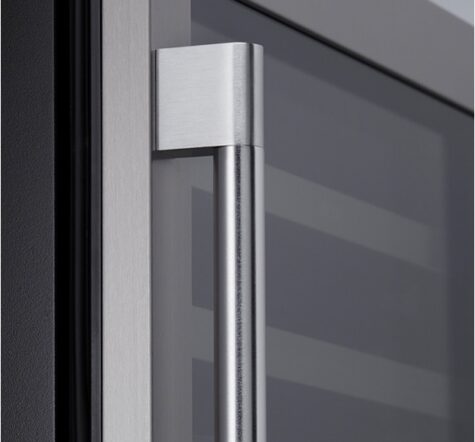Show search results for:
-
All
-
Range Hoods
-
Wine & Bev Coolers

Show search results for:
Zephyr range hoods and kitchen vents offer quiet performance, superior craftsmanship, and performance versatility. Our range hoods aren’t just powerful. They’re powerfully quiet, serving up great ventilation free of noise so you can enjoy entertaining family and friends. With an unrelenting eye for detail, we deliver exceptional quality fit and finish you can see, feel, and appreciate. Our products offer a wide range of power and innovation starting with our universal make-up air dampers, exclusive Airflow Control Technology (ACT™) and CFM levels ranging from 250 up to 1,300.
We have continued our commitment to unexpected design with specialty kitchen appliances with the introduction of Presrv™ Wine & Beverage Coolers. Presrv™ reflects the smart design and technology of our original products in a whole new context, with our signature, superior craftsmanship.
In addition to our quality craftsmanship and patented technology, we back our products with an unparalleled level of service and a multi-year warranty. Our friendly customer care team is here to help with any questions you might have. For more product service and warranty information, please visit our Help Center.
Proper kitchen ventilation will provide a more comfortable living space and a healthier home environment. It’s estimated that the average family of four produces up to ONE GALLON of grease every year during the process of cooking.
Where does all that grease go if not vented properly?
In many homes, indoor air quality is often worse than outdoor air quality. Because of this, good ventilation will help remove airborne particles that may adversely affect the health of you and your family, which is particularly beneficial for any family members with asthma or allergies.
There are numerous benefits to installing a high performing range hood in your home. Proper ventilation decreases mildew, peeling and discoloration of wall finishes due to moisture and contaminants. It minimizes residue and build-up of cooking odors and grease in draperies, walls, cabinets, clothes, and upholstery fabrics. Installing proper kitchen ventilation will also removes excess cooking heat and household chemical vapors like carbon monoxide (CO), nitrogen dioxide (NO2), and airborne volatile organic compounds (VOCs).
Research has indicated that people spend 90% of their time indoors. Many risks to health may be greater due to poor indoor air quality, and good kitchen ventilation can reduce emissions.
Air in homes that use gas cooking appliances typically don’t meet EPA standards for outdoor air quality, and they don’t regulate indoor air quality.
Homes exceed standards for:
Proper ventilation removes airborne particles that may adversely affect the health of you and your family and refreshes the air you breathe — making living at home as comfortable as possible.
A range hood’s performance is measured in Cubic Feet per Minute (CFM). This is a measure of how much air can be removed from a given space in a single minute. Another way of thinking of CFM is horsepower in a car. It’s really a measure of performance.
A British Thermal Unit is the amount of heat energy needed to raise the temperature of one pound of liquid water by one degree from 60 to 61 degrees Fahrenheit. More importantly, BTUs is the performance measurement of all gas ranges. A typical range BTU measurement is 60,000 BTU.
There are two common methods to determine the range hood CFM you need:
We recommend using the higher of the two.
The power of your cooktop or range is the most important factor in determining your CFM needs. Not all cooking appliances are created equal, different formulas are needed to determine the CFM you need based on the type of cooking appliance you have. Gas cooking appliances have the highest emissions and typically need a range hood with higher CFM compared to electric (radiant and induction) cooking appliances.
These formulas are a guide with the assumption that all burners are being used on high at the same time. Your cooking style and habits may also impact the CFM you need.
60,000 BTU’s ÷ 100 = 600 CFM
(36” cooking surface) 3 x 150 = 450 CFM
If you do not know which cooking appliance you will have, you can use the size of your kitchen as a guide when determining the CFM you need. A range hood should be able to exchange the air in the kitchen at least 15 times per hour, or every 4 minutes. For example, if your kitchen is 15’ wide x 15’ long with a 9’ ceiling, it would contain 2,025 cubic feet of space. 15x15x9 = 2025
To find the CFM needed for your kitchen size, divide the cubic feet of the room by 4.
2,025 Cubic Feet ÷ 4 = 506 CFM
The range hood’s required footprint to properly capture and extract airborne pollutants. Although every application is different, the following guidelines will ensure that the hood dimensions are adequate to provide good capture area:
Mounting height refers to the height from the bottom of the range hood to the top of the cooking surface below. Installing the range hood within the recommended mounting height range aids in the safe and efficient operation of the range hood. For the best performance, mount the range hood as close to the minimum mounting height as possible.
For more information on the specific mounting height per product, explore our Hood Height Calculator tool.
It is always recommended to duct your range hood to the outside. However, when ducting the range hood is not possible, a recirculating kit is needed. Recirculating kits work in conjunction with the range hood’s grease filters. Contaminated air first flows through the grease filters where grease and particulates are captured and then the air is purified through a charcoal filter that traps odors and smoke. The air is then reintroduced into the kitchen environment grease and odor free.
A recirculating kit is a good alternative when there is no option to exhaust air to the outside environment. Learn more about the ductless recirculating option under “Basics of Ducting.”
A sone is an internationally recognized measurement of loudness. It is a unit of loudness as perceived by a person with normal hearing. This is the level and quality of noise your range hood will emit in a kitchen environment when properly ducted.
| Whisper | <1 sone |
| Refrigerator | 1 – 2 sones |
| Normal conversation | 3 – 4 sones |
| Busy restaurant | 5 – 6 sones |
| Traffic noise | 7 – 10 sones |
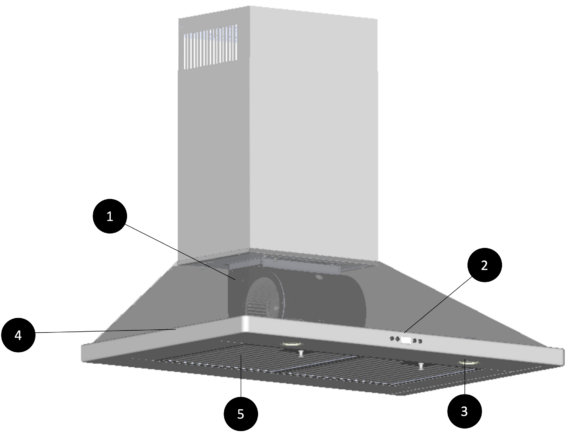
| 1. Wall | 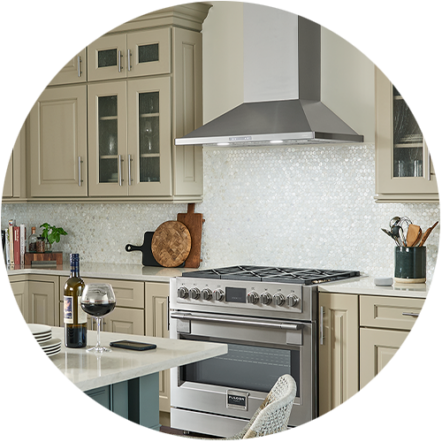 |
| 2. Island | 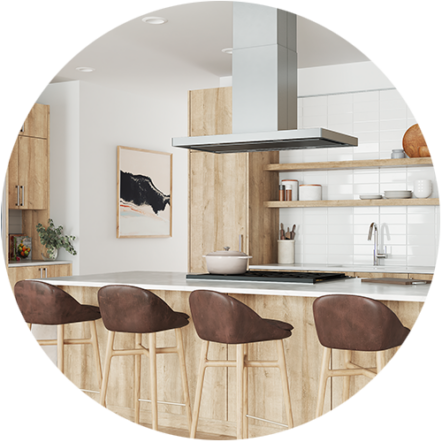 |
| 3. Under-Cabinet | 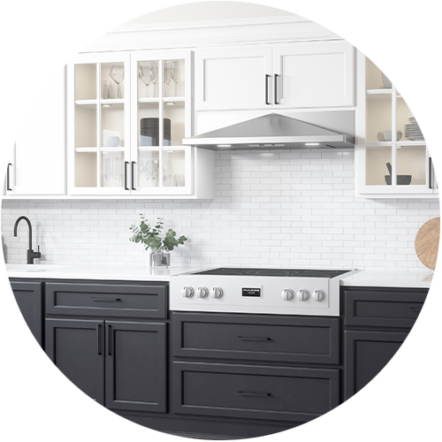 |
| 4. Insert | 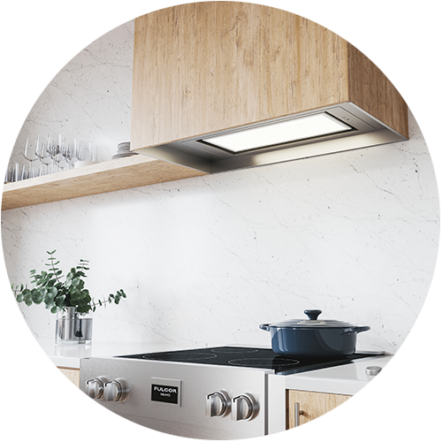 |
| 5. Downdraft | 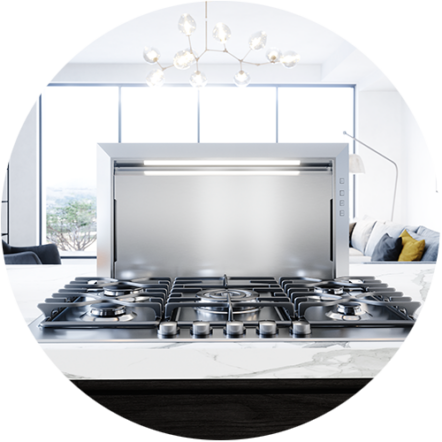 |
Range hood blowers come in several configurations. Zephyr offers blowers that can be installed inside the range hood (internal), inside the ceiling or under the floor (in-line), or on a side wall or roof of the house (external).
Internal Blower: A blower that is mounted inside the hood.
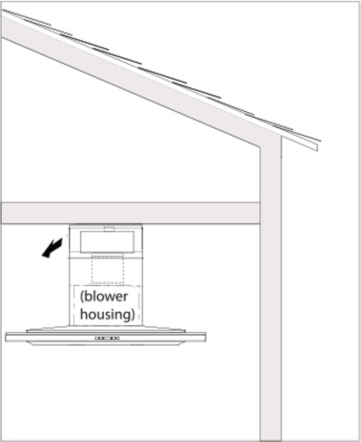
External Blower: A blower that is mounted to the exterior of the home.
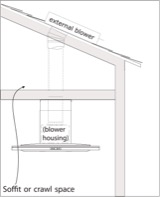
In-line Blower: A blower that is mounted within the interior of the home but away from the hood.
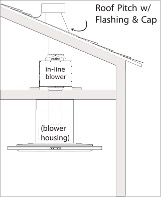
Ducting is the most important component of ventilation. Ensure optimal performance by following these simple rules of thumb:
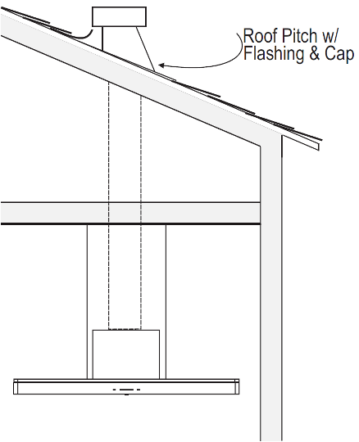
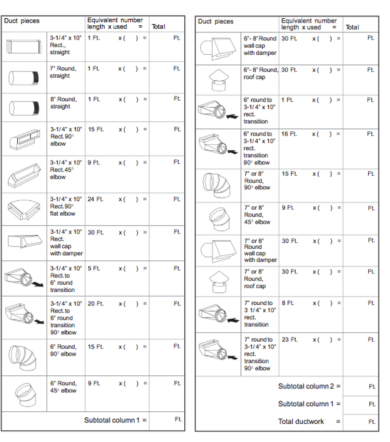
The mounting height and size of the hood plays a critical role in the performance of the hood.
Check your range hood spec sheet or installation manual for the appropriate mounting height range.
A recirculating kit is used when venting air to outside of the home is not possible. It works by using charcoal (carbon) filters to filter out impurities such as smoke and odors before recirculating the air back into the kitchen. The hood’s grease filters are still used to filter grease and particulates while the charcoal filters are typically installed above the grease filters.
Some recirculating kits include an air diverter plate that is installed onto the hood to direct the air back into the kitchen. Other hoods have air diverter plates already built into the hood.
TIP: It is always recommended to vent the hood to the outside for maximum performance, but a recirculating kit is a good alternative if venting out of the home is not possible.
| Core Collection — Classics never go out of style. Much more than just functional products, each product in the Core Collection can serve as the ultimate foundation of a great kitchen. |  |
| Pro Collection —Power, Performance, Size – the sleek, powerful, muscular products in the Pro Collection go above and beyond simple ventilation technology. The hoods in the Pro Collection have been developed for the most discerning of tastes when nothing but the best, the biggest and the most impressive will do.
Range hoods that are classified as “professional” must meet two out of the three following requirements:
|
 |
| Designer Collection — At Zephyr, great design is never an afterthought or a luxury – it’s a way of life. Along with our designer partnerships, we’ve created a visionary collection that fuses groundbreaking engineering with contemporary lines and an expression of artistry with powerful performance. |  |
Over the years, homes have become more tightly sealed due to improved construction techniques. While a better-sealed home is good for energy savings, there is one major drawback: negative air pressure. Negative air pressure occurs when you exhaust air more quickly than you can replace it. When negative air pressure occurs, the air drafts back in through naturally vented combustion devices such as fireplaces and water heaters, which can ultimately bring harmful gases, smoke, and particulates into the home. Negative air pressure also causes air to flow back through windows and doors, which can cause mold, mildew, and uncomfortable drafts. Many local codes limit the maximum CFM to 400 if no make-up air kit is used. Check your local codes for more information.
There are two different solutions to address make-up air requirements. Install a make-up air system (passive or active) or install a range hood that does not exceed the make-up air requirement.
There are two different make-up air solutions: passive or active.
Passive make-up air systems typically consist of a mechanized damper and a sensor. The purpose of a passive make-up air system is to balance air pressure in the home. The sensor tells the damper to open whenever the hood is turned on. When the damper opens, it allows air to passively enter the home. (“Passive” means there is no fan pushing the air back in.)
Passive make-up air systems are generally less expensive than active systems and are simply designed to balance pressure within the home. Outside air is not conditioned in any way with a passive system. Ultimately, local codes will determine which type of system will be needed for a home.
The most common passive system is a make-up air damper kit which consists of the following:
Also known as whole house ventilation, active make-up air systems balance pressure in the home but have HRV and ERV qualities. These systems continuously monitor the air inside a home and activate when needed — when a range hood turns on, when pressure changes, etc. Active make-up air systems have their own fan system inside to bring air in, condition the air, and then expel it from within the home. These systems are typically installed on a roof or inside an attic as they are much larger than passive make up air systems.
If installing a make-up air system is not possible, you can reduce the range hood CFM to meet local make-up air requirements. While we recommend installing a make-up air system to ensure you have the CFM performance needed, there are two more solutions.
Purchasing a range hood or blower with a CFM level that meets your local make-up air regulations is one option.
Airflow Control Technology™ (ACT™) is a feature offered in select range hoods that allows installers to limit the maximum blower CFM to meet local code requirements. ACT™ is available on more diverse product offerings and allows the CFM to be reduced to 590, 390, or 290 CFM levels to accommodate most make-up air codes.
Properly maintaining your range hood is as important as choosing the correct range hood. While nobody likes cleaning their appliances, taking care of your range hood will extend its life and ensure it is properly functioning.
The most important components to keep clean in a range hood are the grease filters. Grease filters come in a variety of styles such as aluminum mesh or stainless steel baffle. Over time, dirty grease filters will inhibit the range hood’s performance. It is recommended to clean grease filters monthly or more frequently depending on your cooking style. Some range hoods will even notify you when it is time to clean the filters. Grease filters can be cleaned in the dishwasher on a low setting or in a sink with warm soapy water.
If your range hood is converted to ductless recirculating mode, you will also have a set of charcoal filters behind the grease filters that need to be replaced every 3 to 4 months or when the hood reminds you.
Part of proper range hood maintenance also includes proper range hood use. Not only does proper hood usage help keep the product in the best condition over the long term, but it also leads to the most efficient ventilation of fumes from the kitchen.
We recommend turning the range hood on to the lowest speed setting for at least 5 minutes before you start cooking. This will create an updraft that will guide the fumes directly into the stream of air the hood has created. Incrementally increase the fan speed level of your range hood as fumes and odors increase during the cooking process. Only use the range hood’s max speed setting if you’re using all burners at maximum BTU output. When finished, leave the hood on for 5 to 10 minutes, or use the delay-off timer to ensure all contaminants have been exhausted from the kitchen.
We’re proud to offer the industry’s first Airflow Control Technology™ (ACT™), an exclusive feature built into specific Zephyr hoods which can limit the maximum blower CFM to 590, 390 or 290 to meet local code requirements.
Cooking contaminates are pulled in through two entry points to improve capture performance. Dual capture zones are featured as part of the Designer Collection in the Horizon Wall range hood.
The Glo™ LED PAS Light Panel showcases a built-in Perimeter Aspiration System to keep your kitchen fresh while illuminating your space with soft light. This feature is included in our Tornado Glo Insert range hood.
Perimeter aspiration is a form of ventilation that moves airflow away from the central area and evenly distributes it through narrow openings around the perimeter of the hood. This ventilation method increases air velocity and improves the capture of cooking contaminates. Our Perimeter Aspiration System (PAS) is featured in the Tornado Glo Insert, Lux Island, Vista Island, Vista Wall, Layers Wall, Apex Wall, and Pyramid Under-Cabinet range hoods.
Zephyr PowerWave™ is designed to deliver best-in-class performance with unparalleled quiet operation, it is a breakthrough in kitchen technology. The first range hood blower with three-phase AC power, PowerWave™ has unique aerodynamic blades to help move up to 750 CFM of air while minimizing noise and improving efficiency. PowerWave™ is also versatile by allowing you to combine two blowers together to achieve 1,300 CFM, making it the most powerful dual-internal blower system on the market. It’s a leap forward in range hood performance that can only have been imagined by Zephyr.
Zephyr Connect range hoods are compatible with the Zephyr Connect app, which allows you to control your range hood remotely from anywhere using a Wi-Fi network and internet. Change the fan speed, set the delay-off, turn lights on/off, and more. Zephyr Connect provides detailed product information and will send users helpful notifications such as clean filter reminders and if the hood was turned off after use. The Zephyr Connect app seamlessly interacts with your smart devices such as Amazon Alexa or Google Home smart speakers for voice activation. Available to download on mobile devices from Google Play or the Apple App Store. For more information such as compatible range hood models, visit our Zephyr Connect page.
Select Zephyr range hoods come standard with a wireless remote control, which meets the American Disabilities Act requirements for ADA compliance. An optional wireless remote control accessory is also available on select ADA-compliant models.
Roma Groove features two built-in Bluetooth® speakers that are compatible with Bluetooth®-enabled devices.
Select Zephyr range hoods feature our CleanAir Function that will turn the hood on once every four hours for 10 minutes to ensure the air is properly recirculated.
Any Zephyr range hoods featuring PowerWave™ technology also come with the CleanAir Function, including the Roma Pro Wall, Titan Wall, and Titan Island.
Select Zephyr range hoods include an automatic delay-off feature, which allows you to set your hood to continue venting for 5 or 10 minutes after cooking is complete and then automatically powers your hood off.
ENERGY STAR® is a trusted symbol for superior energy efficiency. Products that are ENERGY STAR® approved must go through a rigorous certification process to meet requirements based on a set of key guiding principles and use 20 to 30 percent less energy than required by federal standards. The products must contribute significant energy savings nationwide, without sacrificing performance, features and comfort.

Select Zephyr range hoods are built with corrosion-resistant 304-grade stainless steel for outdoor kitchen installations. Browse our range hood product pages to view all of our outdoor range hood options.
Wine and beverage units provide two primary benefits aside from convenience:
Zephyr Presrv™ Wine & Beverage Coolers offer quality performance and a quality build. Presrv™ coolers maintain steady temperatures and humidity throughout the units and are designed to minimize vibration and UV light, keeping your wines in the optimal storage conditions. Our coolers are built with quality components and touch points, and they are exceptionally quiet in operation, which sets a soothing ambiance for any room.
Long term wine storage temperatures range from 53° to 57° for all types of wine. Maintaining a steady temperature is the target. This allows the wine to age and develop as the winemaker intended.
Serving temperatures vary by the wine varietal. The general rule of thumb is the lighter the wine, the cooler it is served. Regardless, no wine should be served at room temperature.
The right amount of humidity allows the cork to function properly over many years. If it’s too wet or dry, the cork will allow molds or air to spoil the bottle.
Fortunately, keeping bottles for less than a year does not give enough time for humidity to effect the cork.
Keeping your wine still is equally important as temperature and humidity. Vibration disturbs the wine and its development over time, ultimately dulling the flavor.
Vibration can bother wine even if keeping them less than a year. It can dull flavors and the nose.
Sunlight or incandescent light will react with phenolic compounds in wine damaging the taste. Hence why wine caves provide a near ideal environment for storing wines.
| Sparkling Wine: 45° to 48° F | Asti, Prosecco, Champagne |
| Light Whites: 45° to 50° F | Rosé, Sauvignon Blanc, Pinot Grigio |
| Full Bodied Whites: 50° to 55° F | Chablis, Chardonnay, Viognier |
| Light Reds: 55° to 60° F | Beaujolais, Pinot Noir, Barbera |
| Full Bodied Reds: 60 to 65° F | Bordeaux, Merlot, Cabernet, Sauvignon, Syrah |
Our Presrv™ Dual Zone Wine Coolers give you the flexibility to store any wine at the temperature of your choice.
Temperature, humidity, vibration and light all affect beer similarly to wine.
For storing beer, we follow the 3-30-300 rule for storing mass market beer and recommend you drink them in 3 to 6 months. Flavor loss typically occurs in:
Vintage beers, barley wines, imperial stouts, lambics, old ales, etc. can be aged from one to ten years or more to build complexities. IPAs have a shorter shelf life than most beers and should be consumed at a quicker rate.
Ideally, the temperature you store your beer at is also the temperature you want to serve your beer at. Storage temperature can affect the flavor and quality of your beer. Near freezing temperatures mask flavors, and the beer retains more CO2. Below are recommended storage and serving temperatures for various types of beer:
| 38° to 45° F | Light bodied beer |
| 45° to 50° F | Lighter lagers, pilsners, wheat beers |
| 50° to 55° F | Standard ales like Bitters, IPA’s, Dobbelbocks, Lambics, and Stouts |
| 55° to 60° F | Strong bodied beers, dark Ales, and tripels |
Try some of these general beer storage tips and tricks to protect your investments:
| Single Zone — Features one temperature zone for the entire cooler. |  |
| Dual Zone — Features two evaporators to control two distinct temperature zones for more accurate temperature control. |  |
| Compact — Refers to any Presrv™ coolers with a height under 34 inches. Units can be freestanding or built-in. |  |
| Full Size — Refers to any Presrv™ cooler with a height over 69 inches. Units can be freestanding or built-in. |  |
| 15-Inch Width — Zephyr Presrv™ coolers featuring a 15-inch width. |  |
| 24-Inch Width — Zephyr Presrv™ coolers featuring a 24-inch width. |  |
| Stainless Steel + Glass — Multiple Zephyr Presrv™ coolers feature a 304-grade stainless steel door with dual-pane, Low-e, argon-filled glass. |  |
| Solid Stainless Steel — Select Zephyr Presrv™ beverage coolers feature a solid door with a 304-grade stainless steel finish. |  |
| Black Stainless Steel + Glass — Select Zephyr Presrv™ coolers feature a black stainless steel door with dual-pane, Low-e, argon-filled glass. |  |
| Panel-Ready + Glass — Zephyr Presrv™ panel-ready coolers ship with an unfinished door to allow you to apply a custom wood overlay panel to match your cabinetry. Door handles are sold separately from panel-ready coolers. |  |
| French Door — Zephyr Presrv™ French door models feature two doors and two distinct temperature zones for storing your wine and beverages. |  |
| ADA Compliant — Zephyr Presrv™ ADA coolers are under 32 inches in height for compatibility with ADA-compliant counter heights. |  |
| Outdoor Rated — Zephyr Presrv™ outdoor coolers are tested for use in outdoor environments and feature a full stainless steel exterior. |  |
| ENERGY STAR® — Multiple Zephyr Presrv™ coolers and kegerators are ENERGY STAR rated. ENERGY STAR® is a trusted symbol for superior energy efficiency. Products that are ENERGY STAR® approved must go through a rigorous certification process to meet requirements based on a set of key guiding principles and use 20 to 30 percent less energy than required by federal standards. The products must contribute significant energy savings nationwide, without sacrificing performance, features and comfort. |  |
| DoE Listed — All Zephyr Presrv coolers are Department of Energy listed, which is a requirement to sell in the United States. |  |
An on-board computer controls active cooling fans to provide temperature stability and even cooling.
When we reference bottle capacity for our wine (and beverage) coolers, we are referring to the maximum quantity of standard 750ml Bordeaux-style bottles that will fit into that particular cooler. In reality, there is no true “standard” bottle size in today’s wine market. If your collection includes any of these non “standard” Bordeaux-style bottles, your capacity can be lower than what we advertise the unit can hold.

In select Zephyr Presrv™ wine coolers, a 7- or 9-bottle capacity rack accommodates large diameter bottles such as specialty craft beers, pinot noir, chardonnay, and champagne.

A built-in carbon filter protects your beverages by acting as a natural barrier against harmful odors. The carbon filter should be replaced every 3 to 6 months depending on the unit’s exposure level to odor. If the unit is placed in a kitchen, regular replacement every three months is ideal.
For more information, consult your Presrv™ cooler user manual. To purchase replacement carbon filters, please visit our Parts & Accessories Store.

All Presrv™ Wine & Beverage Coolers can be built-in or freestanding. Units come with a field-reversible door for more flexibility with installation and use. All Presrv™ Wine & Beverage Coolers also come standard with zero-clearance door hinges.

Improves insulation to minimize heat exchange and increases soundproofing characteristics. A Low-e coating helps minimize the amount of UV and infrared light that passes through the glass door.
Presrv™ Wine & Beverage Coolers are designed to minimize vibration and light and keep both from disturbing your bottles:
Multiple internal sensors help maintain accurate temperatures for precise cooling throughout the unit.
Zephyr Presrv™ Wine & Beverage Coolers feature one or more Full-Extension, Black Wood Racks with Stainless Steel Trim. All of the wood is untreated to avoid any staining and to keep the rack from absorbing moisture and swelling.

*To accommodate fluctuating and varied outdoor climates and elements, our Presrv™ Outdoor Single Zone Beverage Cooler is equipped with a Full-Extension Black Wire Rack in place of the Full-Extension, Black Wood Rack with Stainless Steel Trim.
Our indoor Presrv™ Beverage Coolers all feature Adjustable, Transparent-Gray Glass Shelves with Airflow Openings to maintain even temperatures throughout the units.

For more information on the shelving for each Presrv™ model, explore our entire Presrv™ Wine & Beverage Cooler Collection.
Presrv™ Wine & Beverage Coolers maintain steady temperatures and humidity levels throughout each unit due to their design:
Presrv™ Wine & Beverage Coolers feature 3-Color LED Lighting in Cloud White, Deep Blue and Amber to set the mood for any occasion.
Cloud White
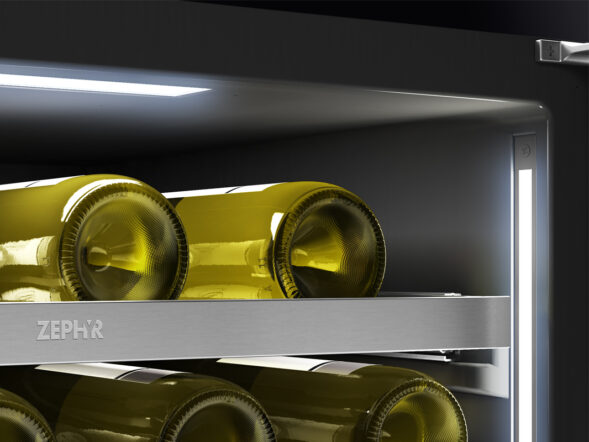
Deep Blue
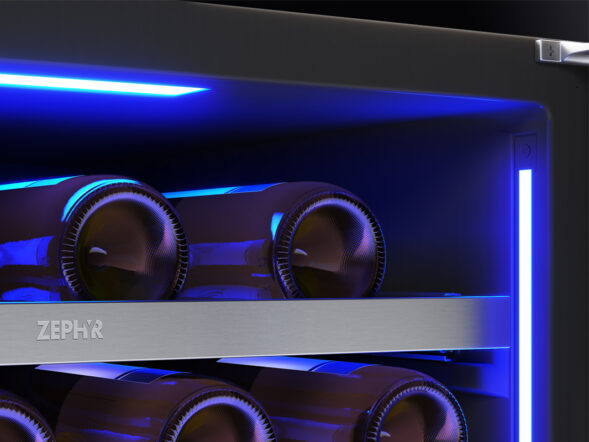
Amber
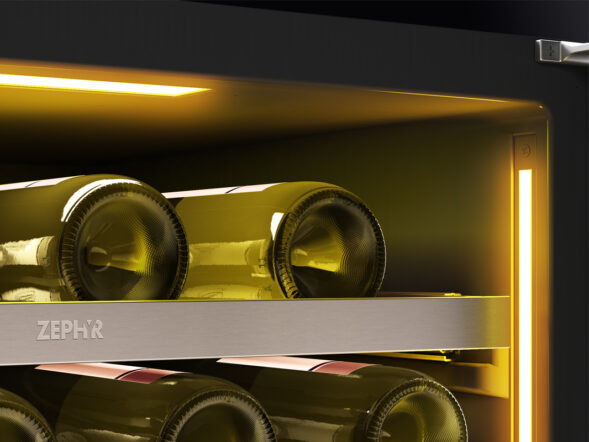
*Our Presrv™ Outdoor Single Zone Beverage Cooler only features Cloud White lighting.
An isolated compressor, smooth running fan motors, heavy-duty cabinet and high-quality components help reduce noise and vibration to minimize wine disturbance. The high quality compressor is designed for long life and quiet operation.
Our Presrv™ Wine & Beverage Coolers are built with welded and polished, 304-grade stainless steel. Each unit comes with a sleek contemporary-style door handle.

*For Presrv™ Panel-Ready Wine & Beverage Coolers, the contemporary-style door handle is sold separately from the unit as optional accessory.
The following features are available in all Zephyr Presrv™ Wine & Beverage Coolers:
The Presrv™ 24-inch Single Zone Beverage Cooler features a Retractable Gray Glass Quarter-Shelf that maximizes the space and flexibility to display taller bottles such as water, 2-liter bottles of soda, or champagne. This is available on model PRB24C01BG.
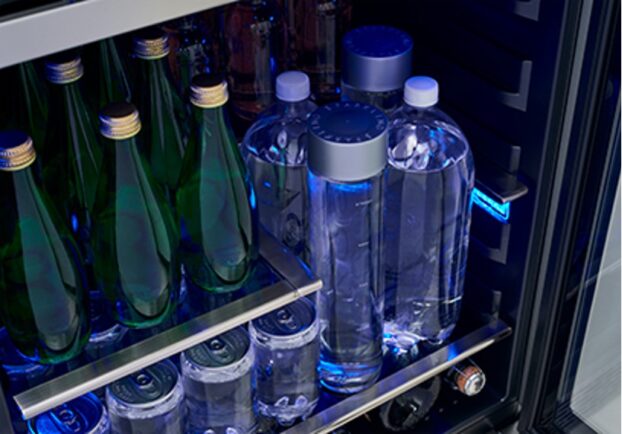
To complement any room design, our sleek contemporary door handle in brushed gold can be purchased as an optional accessory for use with any of our compact Presrv™ wine and beverage coolers. For the Presrv™ French door wine coolers, two brushed gold contemporary door handles must be purchased.
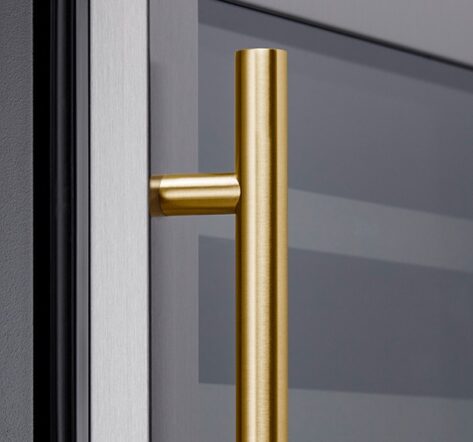
To complement any room design, our sleek contemporary door handle in matte black can be purchased as an optional accessory for use with any of our compact Presrv™ wine and beverage coolers. For the Presrv™ French door wine coolers, two black matte contemporary door handles must be purchased.
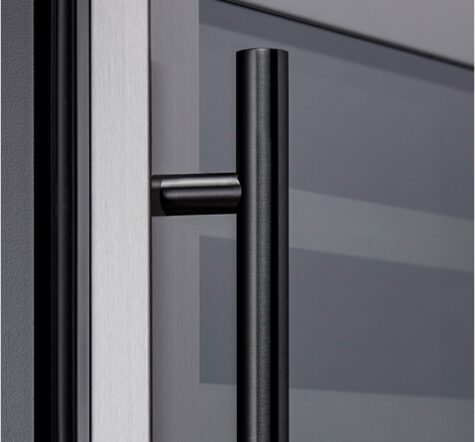
Our optional professional-style door handle accessory will add a professional, polished look to your Zephyr cooler. This optional accessory is compatible with all Presrv™ Wine & Beverage Coolers and is purchased separately from each unit.
